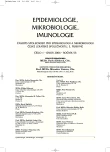-
Medical journals
- Career
Comparison of Efficacy of the Rapid Mycobacteria Growth Indicator Tube (MGIT) Culture Method (Manual System) and Conventional Culture Method in Mycobacterial Detection
Authors: B. Kozáková
Authors‘ workplace: Zdravotní ústav se sídlem v Praze ; Technická spolupráce: Fričová J., Kočková I.
Published in: Epidemiol. Mikrobiol. Imunol. 55, 2006, č. 1, s. 37-40
Overview
Diagnosis of tuberculosis is based on clinical symptoms, lung X-ray, skin tuberculin test and primarily on the detection of the causative agent Mycobacterium tuberculosis by direct microscopy of biological specimens and culture on solid egg media and in liquid media (Ogawa, Löwenstein-Jensen, Šula). Slow growth of most mycobacterial species is a limiting factor in both the confirmation of etiology and subsequent drug susceptibility tests and species identification that are of crucial relevance to early institution of treatment, selection of treatment regimen and implementation of antiepidemic measures. One of the methods proposed for more rapid detection of mycobacteria and suitable for use in routine diagnostic laboratories is the BD BBL MGIT culture system (Becton Dickinson, 1 Becton Drive, Franklin Lakes, NJ 07417, USA) based on fluorescence detection of the initial phase of mycobacterial multiplication at which macrocolony growth is still not visible. The fluorescent compound Tris, 4,7-diphenyl-1,10-phenalthroline ruthenium chloride pentahydrate is embedded in silicone on the bottom of tubes with liquid culture medium in which growing, actively respiring mycobacteria consume the oxygen and allow the fluorescence to be detected and visualized using a UV transluminator.
Key words:
MGIT – Mycobacterium tubercilosis – NTM.
Labels
Hygiene and epidemiology Medical virology Clinical microbiology
Article was published inEpidemiology, Microbiology, Immunology

2006 Issue 1-
All articles in this issue
- Current Epidemiological and Clinical Issues Regarding Helicobacter pylori Infection in Childhood
- Current Prevalence of Toxocariasis and other Intestinal Parasitoses among Dogs in Bratislava
- Methods for Detection of Biofilm Formation in Routine Microbiological Practice
- Vibrio Cholerae 01 in a Fish Aquarium
- Diagnosis of Rotavirus Infections in 2004, Major Characteristics in 1998–2004 in the Czech Republic
- Comparison of Efficacy of the Rapid Mycobacteria Growth Indicator Tube (MGIT) Culture Method (Manual System) and Conventional Culture Method in Mycobacterial Detection
- Epidemiology, Microbiology, Immunology
- Journal archive
- Current issue
- Online only
- About the journal
Most read in this issue- Methods for Detection of Biofilm Formation in Routine Microbiological Practice
- Comparison of Efficacy of the Rapid Mycobacteria Growth Indicator Tube (MGIT) Culture Method (Manual System) and Conventional Culture Method in Mycobacterial Detection
- Current Prevalence of Toxocariasis and other Intestinal Parasitoses among Dogs in Bratislava
- Current Epidemiological and Clinical Issues Regarding Helicobacter pylori Infection in Childhood
Login#ADS_BOTTOM_SCRIPTS#Forgotten passwordEnter the email address that you registered with. We will send you instructions on how to set a new password.
- Career

